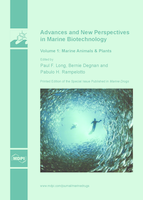Advances and New Perspectives in Marine Biotechnology
A special issue of Marine Drugs (ISSN 1660-3397).
Deadline for manuscript submissions: closed (31 January 2014) | Viewed by 532505
Special Issue Editors
Interests: proteomics; animal venom
Special Issues, Collections and Topics in MDPI journals
Interests: evolutionary genomics; developmental biology; aquaculture; marine biotechnology; marine biology
Interests: microbiome; molecular microbiology; metagenomics; omics; biostatistics; next-generation sequencing; microbial ecology; bioinformatics; biotechnology; system biology; grand challenges
Special Issues, Collections and Topics in MDPI journals
Special Issue Information
Dear Colleagues,
As the Century of Biology begins to bear fruit, through the translation of predictive biological understanding into applications that enhance the human condition and maintain biodiversity, the almost infinite potential of marine biological resources will be unlocked. Although Marine Biotechnology already has delivered products for medicine, food, bioenergy, nanomaterials, and bioremediation, less than 5% of our vast oceanic environment has been explored. Marine Biotechnology is a scientifically and economically expanding enterprise that is poised to harness the enormous but uncharted functional diversity of marine life, with its novel and rich array biodesigns and biosynthetic capabilities. From this pursuit comes new genes, chemicals, materials and inspirations for the benefit of industry, nutrition, medicine and the sustainable use and management of the world’s oceans. This Special Issue in Marine Drugs highlights the cutting-edge developments in Marine Biotechnology with a collection of papers written by authors who are leading experts in the field including selected papers from the 10th International Marine Biotechnology Conference (IMBC-2013), the premier meeting in marine biotechnology under the auspices of the International Marine Biotechnology Association. We cordially welcome you to join us in this endeavor. The submission of comprehensive/mini reviews, original research articles and communications is most welcome.
Prof. Dr. Bernie Degnan
Mr. Pabulo Henrique Rampelotto
Dr. Paul Long
Guest Editors
Manuscript Submission Information
Manuscripts should be submitted online at www.mdpi.com by registering and logging in to this website. Once you are registered, click here to go to the submission form. Manuscripts can be submitted until the deadline. All submissions that pass pre-check are peer-reviewed. Accepted papers will be published continuously in the journal (as soon as accepted) and will be listed together on the special issue website. Research articles, review articles as well as short communications are invited. For planned papers, a title and short abstract (about 100 words) can be sent to the Editorial Office for announcement on this website.
Submitted manuscripts should not have been published previously, nor be under consideration for publication elsewhere (except conference proceedings papers). All manuscripts are thoroughly refereed through a single-blind peer-review process. A guide for authors and other relevant information for submission of manuscripts is available on the Instructions for Authors page. Marine Drugs is an international peer-reviewed open access monthly journal published by MDPI.
Please visit the Instructions for Authors page before submitting a manuscript. The Article Processing Charge (APC) for publication in this open access journal is 2900 CHF (Swiss Francs). Submitted papers should be well formatted and use good English. Authors may use MDPI's English editing service prior to publication or during author revisions.
Keywords
- marine biotechnology
- marine microbiology
- marine drugs, bioactive compounds and bioproducts
- marine genomics, marine metagenomics
- ‘omics’ in marine biotechnology
- drug discovery and development
- biomaterials and nanobiotechnology
- biomineralization, biomineral and biomarker
- marine venoms, toxins and enzyme inhibitors
- drug design and synthesis based on marine natural products
- structural and functional characterization of marine drugs









